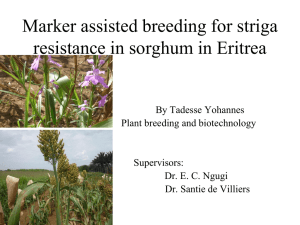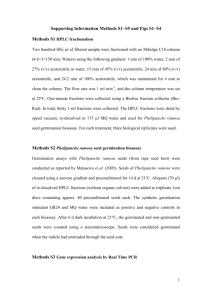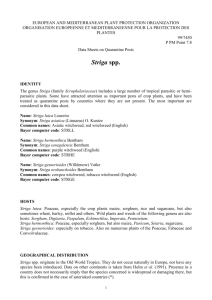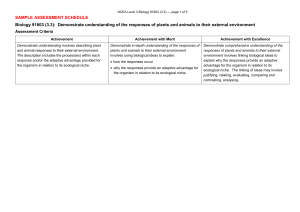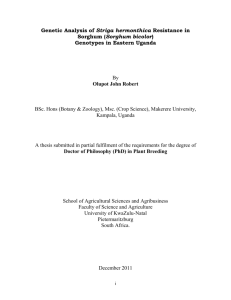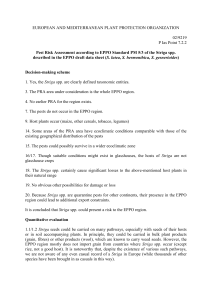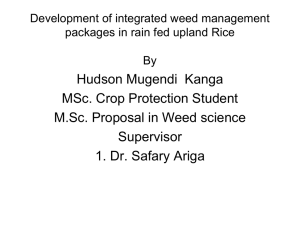Striga-plant - Documents pour le developpements durable
advertisement
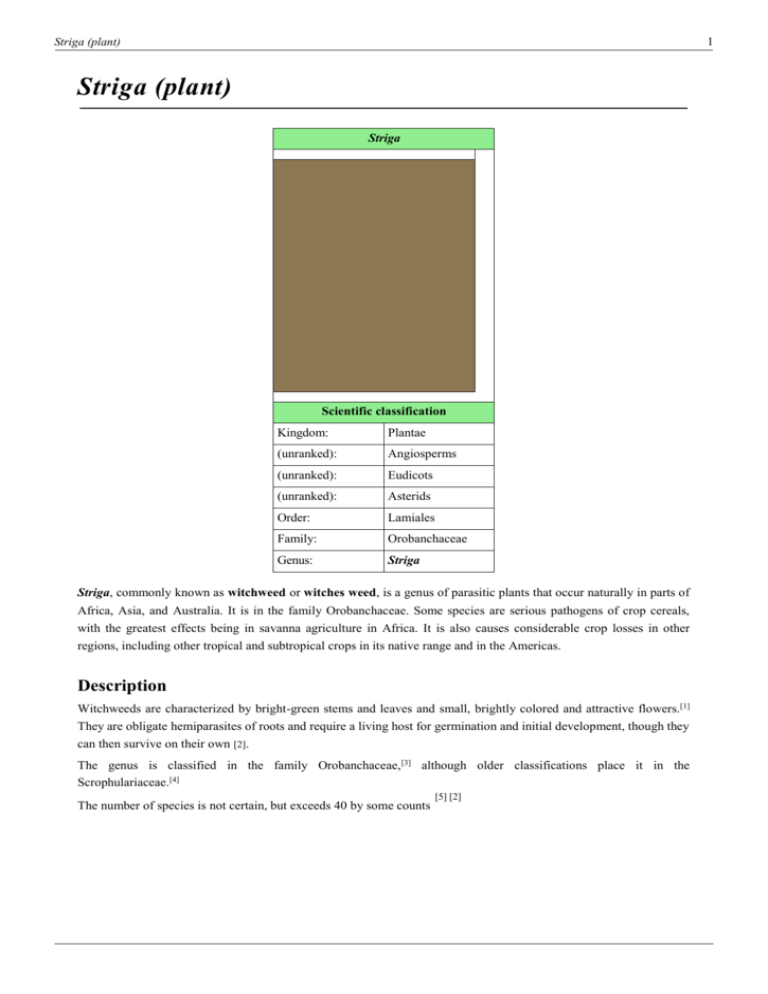
1 Striga (plant) Striga (plant) Striga Scientific classification Kingdom: Plantae (unranked): Angiosperms (unranked): Eudicots (unranked): Asterids Order: Lamiales Family: Orobanchaceae Genus: Striga Striga, commonly known as witchweed or witches weed, is a genus of parasitic plants that occur naturally in parts of Africa, Asia, and Australia. It is in the family Orobanchaceae. Some species are serious pathogens of crop cereals, with the greatest effects being in savanna agriculture in Africa. It is also causes considerable crop losses in other regions, including other tropical and subtropical crops in its native range and in the Americas. Description Witchweeds are characterized by bright-green stems and leaves and small, brightly colored and attractive flowers.[1] They are obligate hemiparasites of roots and require a living host for germination and initial development, though they can then survive on their own [2]. The genus is classified in the family Orobanchaceae,[3] although older classifications place it in the Scrophulariaceae.[4] The number of species is not certain, but exceeds 40 by some counts [5] [2] Striga (plant) 2 Hosts and symptoms Although most species of Striga are not pathogens that affect human agriculture, some species have devastating effects upon crops, particularly those planted by subsistence farmers. [6] Crops most commonly affected are corn, sorghum, and sugarcane.[1] Three species cause the most damage: Striga asiatica, S. gesnerioides, and S. hermonthica. Witchweed parasitizes corn, millet, sorghum, sugarcane, rice, legumes, and a range of weedy grasses. [7] It is capable of significantly reducing yields, in some cases wiping out the entire crop. [1] Host plant symptoms, such as stunting, wilting, and chlorosis, are similar to those seen from severe drought damage, nutrient deficiency, and vascular disease.[1][7][8] Lifecycle Each plant is capable of producing up to 500,000 seeds, which may remain viable in the soil for over 10 years.[9] An annual plant, witchweed overwinters in the seed stage.[1] Its seeds germinate in the presence of host root exudate, and develop haustoria which penetrate host root cells.[1] Host root exudate contain strigolactones, signaling molecules that promote striga seed germination.[10] A bell-like swell forms where the parasitic roots attach to the roots of the host.[7] The pathogen colonizes underground, where it may spend the next four to seven weeks before emergence, when it rapidly flowers and produces seeds.[7] Witchweed seeds spread easily by wind, water, and soil via animal vectors.[7] The chief means of dispersal, however, is through human interaction, by means of machinery, tools, and clothing. [7][9] Environment Temperatures ranging from 30 to 35°C in a moist environment are ideal for germination.[7] Witchweed will not develop in temperatures below 20°C. Agricultural land with light soil and low nitrogen levels tend to Photo of plant roots with connected Striga plant favor its development.[11] Still, witchweed has demonstrated a wide tolerance for soil types if soil temperatures are favorably high. [1] Seeds have been shown to survive in frozen soil of temperatures as low as -15°C, attesting to their aptitude as overwintering structures. [1] Soil temperature, air temperature, photoperiod, soil type, and soil nutrient and moisture levels do not greatly deter the development of witchweed.[1] These findings suggest, though it has been limited to the Carolinas in the United States, that the pathogen would successfully infect the massive corn crops of the Midwest. [1] Striga (plant) Management Management of witchweed is difficult because the majority of its life cycle takes place below ground. If it is not detected before emergence, it is too late to reduce crop loss.[7] To prevent witchweed from spreading it is necessary to plant uncontaminated seeds and clean soil and plant debris off of machinery, shoes, clothing, and tools before entering fields.[7][11] If populations are low, hand weeding before seeds are produced is an option. Striga in the United States has been controlled through the use of several management stategies, including quarantines imposed on affected areas, control of movement of farm equipment between infected and uninfected areas, herbicide application, and imposed "suicidal germination". For the latter, in fields not yet planted in crops, seeds present in the soil are induced to germinate by injecting ethylene gas, which mimics the natural physiological response tied to host recognition. Because no host roots are available, the seedlings die. Unfortunately, each Striga plant can produce tens of thousands of tiny seeds, which can remain dormant in the soil for many years. [12] Thus, such treatments do not remove all seeds from the soil. Moreover, this method is expensive and not generally available to many farmers in developing nations of Africa and Asia. Another method called trap cropping involves planting a species in an infested field that will induce the Striga seeds to germinate but will not support attachment of the parasite. This method has been used in sorghum plantations by planting Celosia argentea between the sorghum.[13] Planting silverleaf (Desmodium uncinatum) has worked in maize crops.[14] Cotton, sunflower, linseed, and witchweed-resistant maize are also effective trap crops.[7] Increasing nitrogen levels in the soil, growing tolerant varieties,and trap-cropping, and planting susceptible crops harvested before witchweed seed is produced, can also be used.[11] Coating maize seeds with fungi or a herbicide also appears to be a promising approach. Several sorghum varieties have high levels of resistance in local conditions, including 'N-13', 'Framida', and 'Serena'.[15] 'Buruma', 'Shibe', 'Okoa' and 'Serere 17' millet cultivars are considered to be resistant in Tanzania. [15] Some corn varieties show partial resistance to witchweed, including 'Katumani' in Kenya. [15] Some crop cultivars, especially corn, are resistant to herbicides that kill witchweed when the haustoria attach to the crop. [16] 'Strigaway' maize has been shown to reduce the seed bank of striga by 30% in two seasons. [16] Importance Corn, sorghum, and sugarcane crops affected by witchweed in the United States have an estimated value well over $20 billion.[1] Furthermore, witchweed is capable of wiping out an entire crop. [7] In fact, it is so prolific that in 1957 Congress allocated money in an attempt to eradicate witchweed. Thus, the Animal and Plant Health Inspection Service (APHIS) of the U.S. Department of Agriculture established a research station and control methods. [9] Through infestation mapping, quarantine, and control activities such as contaminated seed destruction, the acreage parasitized by witchweed has been reduced 99% since its discovery in the United States. [9] APHIS has even offered cash rewards for those identify and report the weed, and encourages landowners to check their own acreage. [9] Parasitizing important economic plants, witchweed is one of the most destructive pathogens in Africa.[8] In fact, witchweed affects 40% of Africa’s arable savanna region, resulting in up to $13 billion lost every year. [15] Striga affects 40 million hectares of crops in sub-Saharan Africa alone.[16] The witchweed infestation is so bad in parts of Africa, some farmers have to relocate every few years.[17] Furthermore, the majority of crops in Africa are grown by subsistence farmers who cannot afford expensive witchweed controls, who therefore suffer much as a result of this pathogen.[17] 3 Striga (plant) 4 Common species Striga asiatica has a very wide geographic distribution, from Africa through southern and eastern Asia to Australia. Since the 1950s, it is also known from the United States. This introduction, likely a result of human activity, resulted in an infestation of corn (maize) across many counties in North and South Carolina. The United States Department of Agriculture and state agencies imposed a quarantine on this area to control its spread - a process that was apparently successful. Striga hermonthica (purple witchweed) is also a parasite that affects grasses, particularly sorghum and pearl millet in subSaharan Africa. Cowpea witchweed, as its name implies, is a parasite of cowpea (Vigna unguiculata), which is not a grass, but a member of the legume family (Fabaceae or Leguminosae). This species was also accidentally introduced into Florida in the United States, where it was found parasitizing Indigofera hirsuta (hairy indigo, another legume). Photo of a striga plant (witchweed) Striga aequinoctialis West Africa Striga angolensis Angola Striga angustifolia East Africa, Asia, Indonesia Striga asiatica (Asiatic witchweed) Africa, Arabian peninsula, India, Burma, China, Indonesia, the Philippines, Malaysia, New Guinea, Australia (introduced?), USA (introduced) Striga aspera Africa Striga bilabiata Africa Striga hirsuta Madagascar Striga brachycalyx Africa. Striga chrysantha Central Africa Striga dalzielii West Africa Striga elegans Angola, Malawi, South Africa, Zimbabwe Striga forbesii Africa, Madagascar Striga gastonii Chad, Central African Republic Striga gesnerioides (cowpea witchweed) Africa, Arabian peninsula, India, USA (introduced) Striga gracillima Tanzania Striga hallaei Gabon, Democratic Rebublic of Congo Striga hermonthica (purple witchweed) Senegal to Ethiopia, Democratic Republic of Congo and Tanzania, Angola, Namibia Striga junodii South Africa, Mozambique Striga klingii West Africa, Nigeria, Ghana, Cameroon, Togo Striga latericea East Africa, Ethiopia, Somalia Striga lepidagathidis Senegal, Guinea, Guinea Bissau Striga lutea Sudan, Ethiopia Striga macrantha West Africa, Nigeria, Ivory Coast, Togo Striga passargei West and Central Africa, Arabian peninsula Striga pinnatifida Ethiopia Striga primuloides Ivory Coast, Nigeria Striga (plant) 5 Striga pubiflora Somalia Striga yemenica Ethiopia Gallery Striga densiflora in Hyderabad, India Striga densiflora Striga densiflora in Hyderabad in Hyderabad Sources [1] Sand, Paul, Robert Eplee, and Randy Westbrooks.Witchweed Research and Control in the United States. Champaign, IL: Weed Science Society of America, 1990. [2] Witchweeds - beautiful but deadly, in The Horticulturalist, Vol. 21-4, October 2012 [3] Nelson D. Young, Kim E. Steiner, Claude W. dePamphilis (Autumn, 1999). "The Evolution of Parasitism in Scrophulariaceae/Orobanchaceae: Plastid Gene Sequences Refute an Evolutionary Transition Series". Annals of the Missouri Botanical Garden 86 (4): pp. 876–893. doi:10.2307/2666173. JSTOR 2666173. [4] For example, Integrated Taxonomic Information System as of 16 Sep 2007 [5] Kamal I. Mohamed, Lytton John Musselman, Charles R. Riches. The Genus Striga (Scrophulariaceae) in Africa. Annals of the Missouri Botanical Garden, Vol. 88, No. 1 (2001) (http:/ / links. jstor. org/ sici?sici=0026-6493(200124)88:1<60:TGS(IA>2. 0. CO;2-I) [6] Nickrent, D. L. and Musselman, L. J. 2004. Introduction to Parasitic Flowering Plants. The Plant Health Instructor. doi:10.1094/PHI-I-2004-0330-01 (http:/ / www. apsnet. org/ education/ IntroPlantPath/ PathogenGroups/ Parasiticplants/ ) [7] Johnson, Annie. New South Wales. Witchweed. 2005. http:/ / www. wyong. nsw. gov. au/ environment/ Weeds_category_one_Witchweed. pdf [8] Agrios, George N. Plant Pathology. 5th ed. London: Elsevier Academic Press, 2005. [9] United States. Witchweed: A Parasitic Pest. District of Columbia: USDA, 2003. http:/ / www. aphis. usda. gov/ publications/ plant_health/ content/ printable_version/ fs_phwitchweed. pdf [10] Matusova, R., K. Rani, F.W.A. Verstappen, M.C.R. Franssen, M. H. Beale, and H. J. Bouwmeester. 2005. The strigolactone germination stimulants of the plant-parasitic Striga and Orobanche spp. are derived from the carotenoid pathway. Plant Physiol. 139:920–934. [11] California Department of Food and Agriculture. Witchweed. http:/ / www. cdfa. ca. gov/ phpps/ ipc/ weedinfo/ striga. htm [12] Mourik, T. (2007) Striga hermonthica seed bank dynamics process quantification and modelling. PhD thesis, Wageningen University. http:/ / library. wur. nl/ wda/ dissertations/ dis4240. pdf [13] J.R. Olupot et al.: The effectiveness of Celosia argentia (Striga chaser) to control Striga on sorghum in Uganda. Crop Protection 22//2003. S. 463-8. Online-Version (http:/ / pdf. dec. org/ pdf_docs/ Pnacw125. pdf) [14] Radford, Tim (September 18, 2003). "Perfect maize, in three simple steps" (http:/ / education. guardian. co. uk/ higher/ research/ story/ 0,,1044085,00. html). The Guardian (London). . Retrieved May 24, 2010. [15] "Purple Witchweed." Infonet-biovision. N.p., 14 Sep 2009. Web. 7 Dec 2010. <http://www.infonet-biovision.org/default/ct/112/pests>. [16] "Controlling Witchweed in Sub-saharan Africa." Web. 7 Dec 2010. <http://www.aatf-africa.org/UserFiles/File/Controlling%20witchweed%20in%20SSA_AATF_Annual-Report_2005.pdf> [17] Samarrai, Fariss. "U.Va. Scientists Identify Gene for Resistance to Parasitic 'Witchweed'." UVaToday. N.p., 27 Aug 2009. Web. 7 Dec 2010. <http://www.virginia.edu/uvatoday/newsRelease.php?id=9543> Striga (plant) Further reading Clark Lawrence J., Shawe Keith G., Hoffmann Gérard and Stewart George R., 1994, The effect of Striga hermonthica (Del.) Benth. infection on gas-exchange characteristics and yield of a sorghum host, measured in the field in Mali. Journal of Experimental Botany 45(2): 281-283 (http:/ / jxb. oxfordjournals. org/ content/ 45/ 2/ 281. short) Hoffmann Gérard., 1994. Contribution to the study of parasitic Phanerogams of Burkina Faso and Mali : some aspects of their ecology, biology and control technics. Doctorate thesis N° 941IX3 0083, University of AixMarseille 3 (France), 242 pages, 282 ref. INIST-CNRS, Cote INIST : T 95870 (http:/ / cat. inist. fr/ ?aModele=afficheN& cpsidt=163863) Hoffmann Gérard, Diarra C, Dembele D, 1994, Outbreaks and new records: Striga asiatica, new pest of maize in Mali. FAO (Food and Agriculture Organization of the United Nations) Plant Protection Bulletin 42 : 214-215. Hoffmann Gérard, Marnotte P., Dembélé D, 1997, Emploi d'herbicides pour lutter contre Striga hermonthica. Agriculture et Développement, n° 13 : 58-62 Khan, Z.R., Hassanali, A., Khamis, T.M., Overholt, W.A., Hooper, A.M., Pickett, J.A., Wahams, L.J.,,Woodcock, C.M., 2002. Control of the witchweed, Striga hermonthica, by intercropping with Desmodium spp., and the mechanism defined as allelopathic. Journal of Chemical Ecology 28: 1871–1885. Khan, Z.R., Midega, C.A.O., Hassanali, A., Pickett, J.A., Wadhams, L.J., 2007. Assessment of Different Legumes for the Control of Striga hermonthica in Maize and Sorghum.Crop Science 47:730-734 Moore T. H. M.; Lane J. A.; Child D. V.; Arnold G. M.; Bailey J. A.; Hoffmann Gérard, 1995, New sources of resistance of cowpea (Vigna unguiculata) to Striga gesnerioides, a parasitic angiospermEuphytica vol. 84, n°3 : 165-174 (http:/ / www. springerlink. com/ content/ j1735m38g7350346/ fulltext. pdf) External links The Parasitic Plant Connection: Striga Photo Gallery (http:/ / www. parasiticplants. siu. edu/ Orobanchaceae/ Striga. Gallery. html) The Parasitic Plant Connection: Striga asiatica in the USA (http:/ / www. parasiticplants. siu. edu/ Orobanchaceae/ Striga. asiatica. html) Witchweed (http:/ / www. cdfa. ca. gov/ phpps/ ipc/ weedinfo/ striga. htm) UN Development Programme (http:/ / www. africa. upenn. edu/ eue_web/ striga. htm) Striga research at the International Institute of Tropical Agriculture (IITA) (http:/ / www. üta. org/ cms/ details/ research_summary. aspx?a=86& z=63) Parasitic Plants as Weeds (http:/ / www. dpw. wageningen-ur. nl/ cwe/ weed_research/ nature-problem. html) Striga weed control with herbicide-coated maize seed, CIMMYT (http:/ / www. cimmyt. cgiar. org/ research/ maize/ results/ striga/ control. htm) A recipe for Striga control in sub-saharan Africa (http:/ / www. idrc. ca/ en/ ev-5575-201-1-DO_TOPIC. html) Sources of Resistance of Cowpea (Vigna unguiculata) to Striga gesnerioides in Mali, West-Africa (http:/ / www. springerlink. com/ content/ j1735m38g7350346/ fulltext. pdf) Facebook community page "Striga Research and Control" (http:/ / www. facebook. com/ media/ set/ fbx/ ?set=a. 220085194674814. 72657. 205932102756790& saved#!/ pages/ Striga-research-and-control/ 205932102756790) 6 Article Sources and Contributors Article Sources and Contributors Striga (plant) Source: http://en.wikipedia.org/w/index.php?oldid=520296973 Contributors: Cennis26, Chowbok, Curb Chain, Delldot, Dina, Franz Xaver, Gigemag76, Hesperian, Imc, J04n, Jmgarg1, Jvhertum, Jwilson, Keilana, Kingdon, LeliwaAB, Llywrch, Marco Schmidt, Miss Madeline, Neutrality, Nickrent, Nunquam Dormio, Nwbeeson, PDH, Patrick Rogel, Plantguy, Ray Chason, Richard Arthur Norton (1958- ), Rjwilmsi, Rwst, Slawojarek, Slightsmile, Smartse, T34, Tomvanmourik, Trekphiler, Wowter, Zeyaurkhan, 10 anonymous edits Image Sources, Licenses and Contributors file:Striga bilabiata MS4167.jpg Source: http://en.wikipedia.org/w/index.php?title=File:Striga_bilabiata_MS4167.jpg License: Creative Commons Attribution-Sharealike 2.5 Contributors: Marco Schmidt File:Striga root connections.jpg Source: http://en.wikipedia.org/w/index.php?title=File:Striga_root_connections.jpg License: Creative Commons Attribution 3.0 Contributors: USDA APHIS PPQ Archive File:Striga plant.jpg Source: http://en.wikipedia.org/w/index.php?title=File:Striga_plant.jpg License: Creative Commons Attribution 3.0 Contributors: Randy Westbrooks Image:Striga densiflora (Agya) in Hyderabad, AP W IMG 9828.jpg Source: http://en.wikipedia.org/w/index.php?title=File:Striga_densiflora_(Agya)_in_Hyderabad,_AP_W_IMG_9828.jpg License: Creative Commons Attribution-Share Alike Contributors: J.M.Garg Image:Striga densiflora (Agya) in Hyderabad, AP W IMG 9826.jpg Source: http://en.wikipedia.org/w/index.php?title=File:Striga_densiflora_(Agya)_in_Hyderabad,_AP_W_IMG_9826.jpg License: Creative Commons Attribution-Share Alike Contributors: J.M.Garg Image:Striga densiflora (Agya) in Hyderabad, AP W IMG 9825.jpg Source: http://en.wikipedia.org/w/index.php?title=File:Striga_densiflora_(Agya)_in_Hyderabad,_AP_W_IMG_9825.jpg License: Creative Commons Attribution-Share Alike Contributors: J.M.Garg License Creative Commons Attribution-Share Alike 3.0 Unported //creativecommons.org/licenses/by-sa/3.0/ 7


